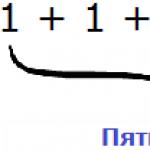A right triangle is a triangle in which one of the angles is 90°. Its area can be found if two sides are known. You can, of course, take the long route - find the hypotenuse and calculate the area using , but in most cases this will only take extra time. That is why the formula for the area of a right triangle looks like this:
![]()
The area of a right triangle is equal to half the product of the legs.
An example of calculating the area of a right triangle.
Given a right triangle with legs a= 8 cm, b= 6 cm.
We calculate the area: ![]()
Area is: 24 cm 2
The Pythagorean theorem also applies to a right triangle. – the sum of the squares of the two legs is equal to the square of the hypotenuse.
The formula for the area of an isosceles right triangle is calculated in the same way as a regular right triangle.
An example of calculating the area of an isosceles right triangle:
Given a triangle with legs a= 4 cm, b= 4 cm. Calculate the area:
Calculate the area: = 8 cm 2
The formula for the area of a right triangle based on the hypotenuse can be used if one leg is given in the condition. From the Pythagorean theorem we find the length of the unknown leg. For example, given the hypotenuse c and leg a, leg b will be equal to:
Next, we calculate the area using the usual formula. An example of calculating the formula for the area of a right triangle based on the hypotenuse is identical to that described above.
Let's consider an interesting problem that will help consolidate knowledge of formulas for solving a triangle.
Task: The area of a right triangle is 180 square meters. see, find the smaller leg of the triangle if it is 31 cm less than the second.
Solution: let's designate the legs a And b. Now let’s substitute the data into the area formula: we also know that one leg is smaller than the other a – b= 31 cm
From the first condition we obtain that
We substitute this condition into the second equation: ![]()
Since we found the sides, we remove the minus sign.
It turns out that the leg a= 40 cm, a b= 9 cm.
In elementary geometry, a right triangle is a figure consisting of three segments connected at points, with angles two of which are acute and one straight (that is, equal to 90°). Right triangle is characterized by a number of important properties, many of which form the basis of trigonometry (for example, the relationship between its sides and angles). Since school, we all know how to calculate area of a right triangle, and in everyday life we encounter this geometric figure quite often, sometimes without even noticing it. It finds quite wide application in technology and therefore engineers, designers and architects often have to solve such a problem.
Architects need to determine this value when they design buildings with pediments, which are the completion of the facades and have triangular shape bounded by a cornice and on the sides by roof slopes. Often the angle between the slopes is straight, and in such cases the pediment has the shape of a right triangle. It is required to determine its area for the simple reason that it is necessary to know exactly the quantity building material necessary for its arrangement. It should be noted that gables are mandatory elements of low-rise buildings (country houses, cottages, dachas).
Finding the area of a right triangle
Formula for calculating the area of a right triangle
| S | ab |
a- leg
b- leg
S- area of a right triangle
Form right triangle have many of the details from which modern furniture is made. As you know, in order to make the most efficient use of room space, all elements of the furnishings must be placed in it in an optimal way. You can make good use of areas such as corners using triangular-shaped tables, the tops of which in most cases are right-angled triangles with legs adjacent to the walls. When designing and calculating these elements, furniture production designers use the formula according to which finding the area of a right triangle is carried out based on the length of its sides. In addition, they often have to develop designs for tables attached directly to the walls, which include supporting elements, which also represent right triangles.
Builders involved in facing work often have to use ceramic tiles, having the shape of a right triangle with legs of the same or different lengths. They also have to determine the area of these elements in order to find out the required number.
Form right triangle It also has such an important and necessary measuring tool as a square. It is used to construct and control right angles, and it is used very widely and by many: from ordinary schoolchildren in geometry lessons to designers of cutting-edge technology.
A triangle is a flat geometric figure with one angle equal to 90°. Moreover, in geometry it is often necessary to calculate the area of such a figure. We will tell you how to do this further.
The simplest formula for determining the area of a right triangle
Initial data, where: a and b are the sides of the triangle coming from right angle.
That is, the area is equal to half the product of the two sides that extend from the right angle. Of course, there is Heron's formula used to calculate the area of a regular triangle, but to determine the value you need to know the length of the three sides. Accordingly, you will have to calculate the hypotenuse, and this is extra time.
Find the area of a right triangle using Heron's formula
This is a well-known and original formula, but for this you will have to calculate the hypotenuse on two legs using the Pythagorean Theorem.
In this formula: a, b, c are the sides of the triangle, and p is the semi-perimeter.
Find the area of a right triangle using the hypotenuse and angle
If in your problem none of the legs is known, then use the most in a simple way You can not. To determine the value you need to calculate the length of the legs. This can be done simply by using the hypotenuse and the cosine of the adjacent angle.
b=c×cos(α)
Once you know the length of one of the legs, using the Pythagorean theorem you can calculate the second side coming out of the right angle.
b 2 =c 2 -a 2
In this formula, c and a are the hypotenuse and leg, respectively. Now you can calculate the area using the first formula. In the same way, you can calculate one of the legs, given the second and the angle. In this case, one of the required sides will be equal to the product of the leg and the tangent of the angle. There are other ways to calculate area, but knowing the basic theorems and rules, you can easily find the desired value.
If you do not have any of the sides of the triangle, but only the median and one of the angles, then you can calculate the length of the sides. To do this, use the properties of the median to divide a right triangle into two. Accordingly, it can act as a hypotenuse if it comes out of acute angle. Use the Pythagorean theorem and determine the length of the sides of the triangle coming from the right angle.


As you can see, knowing the basic formulas and the Pythagorean Theorem, you can calculate the area of a right triangle, having only one of the angles and the length of one of the sides.
Area formula is necessary to determine the area of a figure, which is a real-valued function defined on a certain class of figures of the Euclidean plane and satisfying 4 conditions:
- Positivity - Area cannot be less than zero;
- Normalization - a square with side unit has area 1;
- Congruence - congruent figures have equal area;
- Additivity - the area of the union of 2 figures without common internal points is equal to the sum of the areas of these figures.
| Geometric figure | Formula | Drawing |
|---|---|---|
|
The result of adding the distances between the midpoints of opposite sides of a convex quadrilateral will be equal to its semi-perimeter. |
||
|
Circle sector. The area of a sector of a circle is equal to the product of its arc and half its radius. |
|
|
|
Circle segment. To obtain the area of segment ASB, it is enough to subtract the area of triangle AOB from the area of sector AOB. |
S = 1 / 2 R(s - AC) |
|
|
The area of the ellipse is equal to the product of the lengths of the major and minor semi-axes of the ellipse and the number pi. |
|
|
|
Ellipse. Another option for calculating the area of an ellipse is through two of its radii. |
|
|
|
Triangle. Through the base and height. Formula for the area of a circle using its radius and diameter. |
||
|
Square . Through his side. The area of a square is equal to the square of the length of its side. |
|
|
|
Square. Through its diagonals. The area of a square is equal to half the square of the length of its diagonal. |
||
|
Regular polygon. To determine the area of a regular polygon, it is necessary to divide it into equal triangles that would have a common vertex at the center of the inscribed circle. |
S= r p = 1/2 r n a |







